SaaS for Healthcare | The healthcare industry constantly adopts new technologies to improve its operations and provide the ultimate patient care. One such technology is Software-as-a-Service (SaaS).
Healthcare SaaS has witnessed its widespread adoption in recent times for offering a complete solution to streamline operations, enhance efficiency, and, indeed, patient care.
Lately, more and more healthcare organizations have frequently adopted the said solution and witnessed remarkable benefits. This has increased the market size of this technology. As per the report, the global market size of healthcare SaaS is likely to increase at the rate of 19.5% from 2021 to 2028.
You can either build a custom SaaS product tailored to your needs with the help of a SaaS development company or purchase an existing solution that can be customized.
In this guide, we will cover all the details of healthcare SaaS, including cost to build a SaaS product for healthcare and how to properly implement it into your existing infrastructure. So, keep reading to learn everything you need to know.
What is SaaS in Healthcare?
Healthcare SaaS is basically a cloud-enabled software solution. As the name suggests, the said solution is designed exclusively for the healthcare industry. There are several healthcare software options available in the market that allow healthcare providers to manage everything efficiently and hassle-free.
With the SaaS solution, healthcare providers can improve their workflow, manage patient data, boost operational efficiency, and more. For instance, telemedicine patient portals, electronic health records (EHR), appointment scheduling, billings, etc., are types of healthcare SaaS.
Healthcare SaaS providers host apps in the cloud platform. SaaS solutions come with numerous advantages such as improved collaboration, real-time data sharing, enhanced patient outcomes, and more.
Also Read: SaaS Vs PaaS Vs IaaS: Examples, Advantages, Differences (2024)
Key Features of SaaS for Healthcare
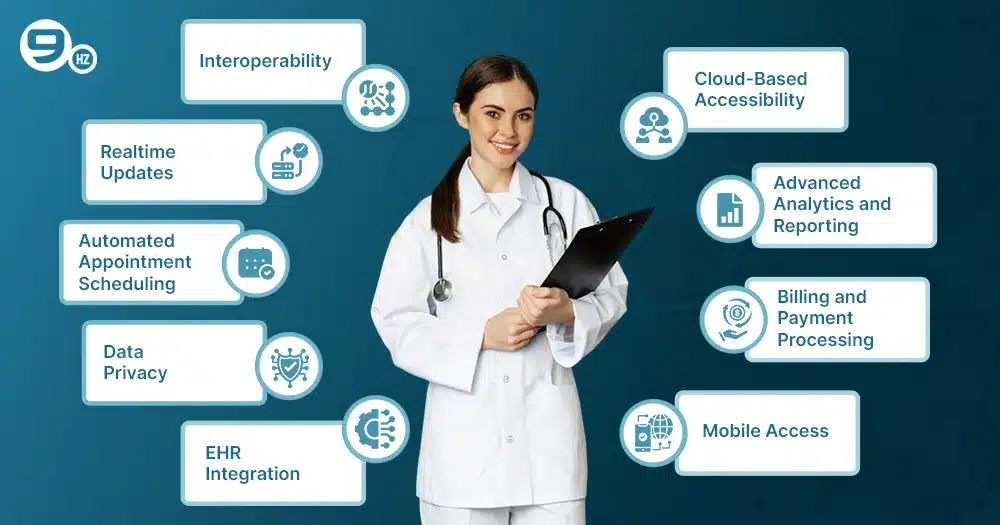
Healthcare SaaS comes with many robust features that make it the most powerful tool for healthcare providers. Let’s explore some of the top and must-have features with detailed explanations.
1. Interoperability
Interoperability means multiple healthcare systems can work and communicate with one another without any hustle. These systems include diagnostic tools, Electronic Health Records. Laboratory systems, and more. It’s indeed quite necessary. The reason is healthcare service providers use various systems.
SaaS platforms bring possibilities for smooth data exchange across multiple systems. It makes it convenient for healthcare experts to access and share patient-related information. It works effectively to improve care coordination and minimizes the chance of any error.
2. Realtime Updates
Real-time updates play a crucial role in decision-making. Healthcare providers can leverage real-time data to improve patient outcomes. Whether it’s updating patient records, analyzing vital signs, or sharing diagnostic results, real-time data enables them to do it all effectively.
With real-time data, healthcare providers find the possibility to adjust their treatment plan quickly based on the situation of the patients. It also enables them to react quickly in emergencies.
For example, medical professionals can utilize real-time data to make plans without wasting time if a patient’s condition worsens. It helps them save the lives of patients.
3. Automated Appointment Scheduling
Appointment scheduling is a crucial task for healthcare providers, often requiring significant time and effort. However, handling appointments manually can be quite tedious and prone to various mistakes. Common issues include missed appointments and the double booking of patients, among others.
Healthcare software help medical professionals overcome this issue. This tool comes with automated appointment scheduling features. Patients can use these features to book appointments on their own.
Besides, they can also reschedule and even cancel their appointments online. It minimizes the administrative task and thus enhances patient satisfaction.
4. Data Privacy
Healthcare service providers frequently handle sensitive patient information. This includes personal identification numbers, medical records, and more. Therefore, it is essential for these providers to maintain the confidentiality of patients’ personal data. SaaS providers help healthcare providers by taking appropriate security measures.
Many healthcare SaaS providers in the United States must adhere to the Health Insurance Portability and Accountability Act (HIPAA). Additionally, in Europe, these service providers are required to comply with the General Data Protection Regulation (GDPR). It ensures all vital details of patients are encrypted and secured.
SaaS healthcare providers also implement security features such as data encryption, multi-factor authentication, regular security audits, etc. These are useful to avert any possibility of cyberattacks or data breaches.
5. EHR Integration
EHR is something that remains of great importance in the healthcare sector. When you integrate EHR with the SaaS platform, it improves the effectiveness and utility of both.
The major advantage of EHR integration is it updates patient data in real-time and also makes it accessible from any location. It also facilitates the sharing of data across many healthcare providers.
It plays a vital role in enhancing the continuity of care and also minimizes even necessary tests and procedures. With the EHR integration, healthcare providers get the ability to quickly access the medical history of patients, treatment plans, test results, etc. These things are possible only from a single platform.
6. Cloud-Based Accessibility
The cloud-based accessibility of the SaaS platform enables healthcare professionals to access various details like patient information, treatment, details, etc. from any location. This feature is pivotal and useful for many remote healthcare service providers.
Cloud-based accessibility allows healthcare service providers to serve patients from any location. These systems provide scalable storage solutions. It brings the possibility for a healthcare organization to store an increased amount of data even without investing in any physical servers. This kind of accessibility improves collaboration among many healthcare teams. It allows for patient-centered and flexible care.
7. Advanced Analytics and Reporting
Almost every SaaS platform is available with an advanced analytic and reporting tool that has a higher ability to generate real-time data based on patient’s demography, financial performance, treatment efficacy, etc.
Advanced analytics are also useful for many healthcare service providers to check at-risk patients, make informed decisions, and analyze various population health trends. This kind of data-based approach causes personalized care plans, higher resource allocation, and enhanced patient outcomes.
8. Billing and Payment Processing
Any healthcare organization can function smoothly with efficient billing and payment processing. As far as SaaS platforms are concerned, these include a billing system that can automate insurance claim processing, automated invoicing, patient payments, etc.
These systems can make the billing process smooth while maintaining a higher accuracy. It can also minimize human error and can make the payment collection process smooth.
This feature ensures a higher transparency for patients who can analyze and manage their bills online effectively. A healthcare provider can minimize administrative costs by automating their billing process and thus can focus more on patient care.
9. Mobile Access
SaaS platform for healthcare includes a mobile-friendly interface. It helps medical professionals access important details like patient data, update records, and communicate with other providers anytime.
Apart from this, it’s also quite useful for many remote healthcare providers. With mobile access, healthcare professionals can connect to their systems easily. It offers better patient care with smooth operations.
We have worked on several healthcare SaaS projects, and we are sharing one of the case study links with you here.
Healthcare SaaS and HIPAA Compliance
Healthcare SaaS needs to comply with HIPAA. It’s necessary for both the security and privacy of protected healthcare information. HIPAA makes it necessary for many healthcare SaaS providers to implement various security measures such as access control, data encryption, regular audits, and more. These work effectively to secure the sensitive data of patients.
To comply with HIPAA, healthcare providers should sign Business Associate Agreements (BAAs). The agreement describes responsibility for data protection.
The SaaS platform should also include various features that ensure HIPAA compliance, including secure data storage and transmission, activity monitoring, user authentication, and more. It helps healthcare providers match regulatory requirements while improving operational efficiency.
Benefits of SAAS for Healthcare Providers
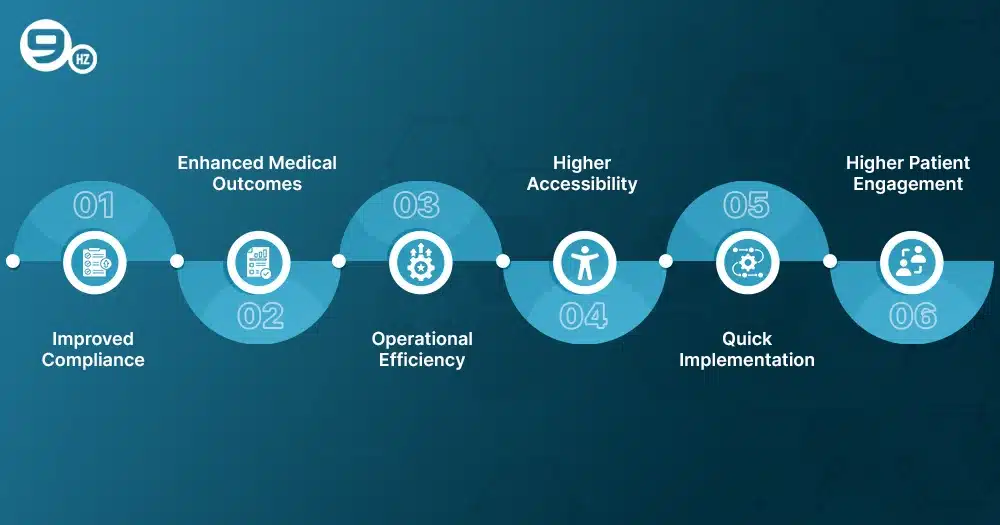
SaaS for healthcare witnessed its vast adoption by offering a myriad of advantages. We will explain here some of the most promising advantages of this platform.
1. Improved Compliance
As previously stated, healthcare providers must adhere to HIPAA in the US and GDPR in Europe. SaaS platforms include various compliance features. These solutions are capable of offering day-to-day updates to healthcare providers who are versed in the regulatory requirements.
SaaS providers ensure the safety of patient information by maintaining audit trails, secure data encryption, access control, etc. These service providers also conduct security audits and certification frequently. It minimizes the burden of healthcare providers for compliance and they can focus only on patient care.
2. Enhanced Medical Outcomes
The cloud-based nature of the SaaS platform enables healthcare professionals to access and share real-time patient data across different departments.
This functionality allows doctors, nurses, and other medical specialists to obtain relevant and up-to-date information whenever needed. Doing this helps them make important decisions accordingly.
Once they have important and accurate data at their fingertips, healthcare teams can improve diagnostics with higher accuracy and various treatment plans. It improves higher patient outcomes.
Many SaaS platforms integrate with cutting-edge analytics tools. These allow healthcare providers to gain fully actionable insights into patient care, operational efficiency, treatment effectiveness, etc.
3. Operational Efficiency
Another benefit of using SaaS healthcare is to increase operational efficiency. SaaS solutions are completely different from traditional healthcare IT systems that need expensive infrastructure, frequent maintenance, dedicated IT staff, and more.
SaaS can reduce these kinds of challenges by centralizing data management. It also offers automatic software updates. Right from patient scheduling to claim processing, SaaS solutions help healthcare providers manage everything systematically.
Automation is pivotal to minimizing administrative burden, human errors, etc. It thus allows healthcare providers to focus more on their core tasks.
4. Higher Accessibility
Since the SaaS platform is cloud-based, it gives an opportunity for medical professionals to access from any location. All they need to have is a fast internet connection. It ensures a higher accessibility for both patients and healthcare service providers.
The feature is prominent, especially in the age where telehealth services have become more popular. It allows physicians to access records of patients irrespective of their location. They can also communicate with patients through the use of virtual platforms. They can collaborate with their colleagues regardless of their location.
5. Quick Implementation
The major advantage of a SaaS solution is it requires less time to deploy. Healthcare providers find it convenient to integrate their cloud-based apps into their workflow quickly with less disruption.
The faster implementation maximizes the possibility of a higher return on investment as healthcare providers start getting benefits from the software quickly.
As we are aware of the fact that a SaaS solution is scalable, it can grow parallelly with your organization. Therefore, it allows many healthcare providers to add several new functionalities or users required without undergoing any major overhauls in the system.
6. Higher Patient Engagement
The SaaS solution allows the patient to schedule their own appointment. Besides, they can do several other tasks like communicate directly with a healthcare provider, see test results, view their medical records, etc.
The secure messaging system is responsible for carrying out the communication process between patients and healthcare professionals. It boosts patient satisfaction with both services and service providers.
Healthcare organizations can utilize patient engagement tools to send automated reminders for a variety of purposes, such as medications, appointments, follow-up care, and more.
7. Automated Backups
Since healthcare providers deal with data, any data loss causes the major issue for them. A SaaS platform is the best option to tackle this problem. It comes with automated backups and disaster recovery solutions. It gives a kind of guarantee that the data is stored securely in the cloud.
An automated backup prevents organizations from any kind of worry about manual data archiving. It minimizes the overall risk of human error and ensures continuous access to crucial patient information. In case of a system failure, SaaS providers can restore data quickly. It minimizes the overall downtime and disruption of healthcare services.
Key Applications SaaS in Healthcare
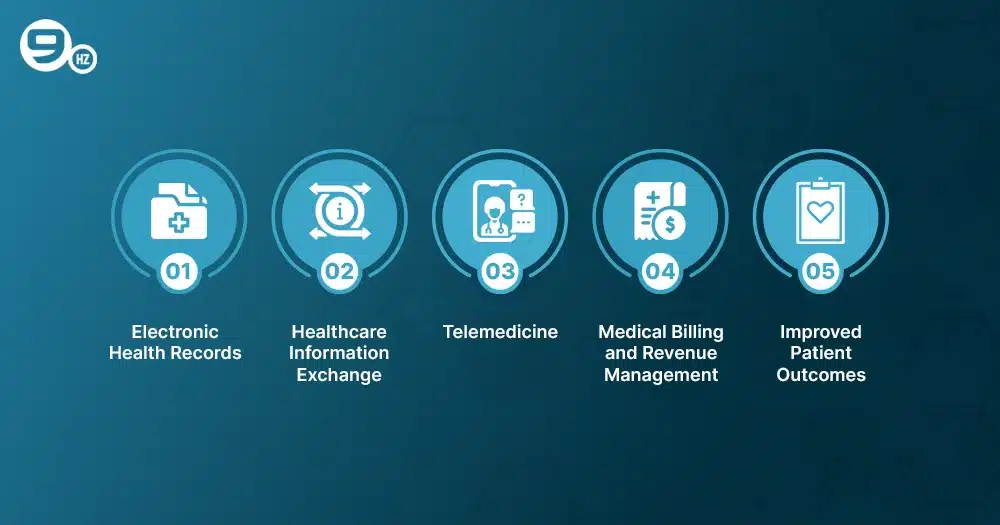
Well, the applications of SaaS in healthcare cover a plethora of aspects, right from administrative tasks to patient engagement. It offers a smooth integration and enhanced service delivery.
1. Electronic Health Records
SaaS-based EHR platform allows many healthcare providers to store, access, and share patient data across multiple healthcare systems securely.
Being cloud-based, EHR allows real-time updates. It ensures many healthcare professionals access updated patient information. It facilitates diagnosis with higher accuracy and personalized treatment plans.
2. Healthcare Information Exchange
SaaS plays a vital role when it comes to Healthcare Information Exchange (HIE). It lets clinics, hospitals, laboratories, etc. share data securely across multiple networks. HIE platform leverages a cloud-enabled system to minimize the necessity for physical data transfer.
It takes coordination among many healthcare providers to the next level. It gives doctors complete information regarding a patient’s health history and helps them provide more comprehensive care.
3. Telemedicine
Telemedicine is evolving of late with a fast pace. It offers virtual consultation and allows patients to get consultation and treatment from doctors from different locations. SaaS has played a lead role in propelling the growth of telemedicine.
It makes the telemedicine platform flexible, scalable, and easy to update. It’s necessary, especially with the virtual healthcare growth. These platforms are easy to integrate with EHR systems while ensuring continuity of care.
4. Medical Billing and Revenue Management
SaaS solutions contribute a lot to improving the overall process of medical billing and revenue management. It automates various tasks such as coding, billing, reimbursement, etc.
These are helpful to minimize errors and delays. These platforms can easily integrate with various software systems and ensure data flow with a higher accuracy, from diagnosis to treatment. It’s useful to maintain the financial health of clinics and hospitals.
5. Improved Patient Outcomes
Improving patient outcomes is a core objective of SaaS solutions. It makes this possible in several ways by offering improved data access, a smooth billing process, remote care, and more.
With SaaS tools, healthcare providers deliver fast, accurate, and fully comprehensive care. It allows patients to get the ultimate benefit from on-time interventions, fewer errors, and improved management of their health.
How to Develop a Healthcare SaaS Application?
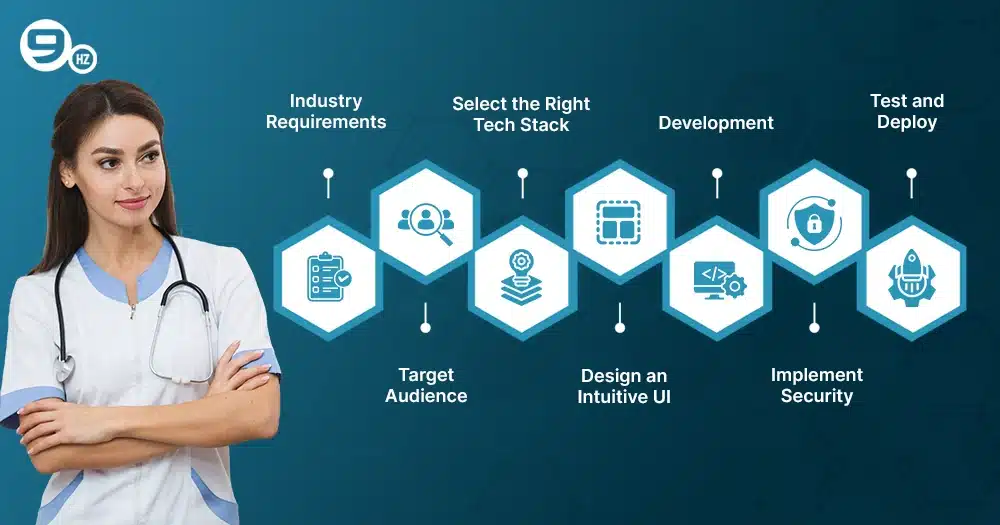
Developing a SaaS healthcare software requires a well-defined strategy and a systematic approach. The development team carries the entire process of healthcare SaaS app development in multiple steps with proper planning. We will discuss here all those steps in detail.
1. Getting Details of Industry Requirements
The healthcare industry must adhere to a range of regulations. For example, as previously mentioned, if you create a SaaS healthcare application in the US, compliance with HIPAA is essential.
It’s advisable to spend enough time to get details about legal and regulatory requirements to ensure the app offers full protection of patient data and also maintains privacy. You can also ensure authentication protocols, data encryption, and role-based access control to protect sensitive health information.
2. Be Aware of your Target Audience and Features
The next step is to find out the specific needs, pain points, etc., of healthcare providers, administration, and patients. You should also be clear about whether your SaaS app can focus on EHR, telemedicine, billing systems, or patient management.
You can implement various important features like appointment scheduling, data sharing, medical reports management, reporting, and more.
3. Select the Right Tech Stack
Selection of the proper tech stack is crucial to ensure the success of your SaaS app. For cloud infrastructure, you can go either with Microsoft Azure or AWS. For programming languages, you can opt for either Java, Python, etc.
These are essential for backend development. Besides, Popular JavaScript frameworks like React and Angular can be the right choice for front-end development.
4. Design an Intuitive UI
User-friendly interface is necessary to ensure the success of any SaaS app. You can create an intuitive and clean user interface that lets users use several features without any difficulty. The aim should be to make design accessible to users from different demographics.
5. Development
Development is a core step that relates to coding SaaS apps according to design. During this phase, developers create both the back and front end of the app with the selected programming languages. They implement the latest coding standards to make apps more advanced and successful.
6. Implement Security
Once they develop an app completely, developers now integrate essential security features into it to ensure its full safety. They implement two-factor authentication.
They also store data in fully compliant and secure databases for maintaining regular backups. Developers implement monitoring features to find out any security issues.
7. Test and Deploy
Thorough testing is quite necessary to check whether the app functions as per expectation or not. It also lets you be aware of if your app complies with healthcare standards.
Besides, testing helps you check bugs and remove them quickly. It makes your SaaS app easily accessible to users.
SaaS Solutions for Different Healthcare Segments
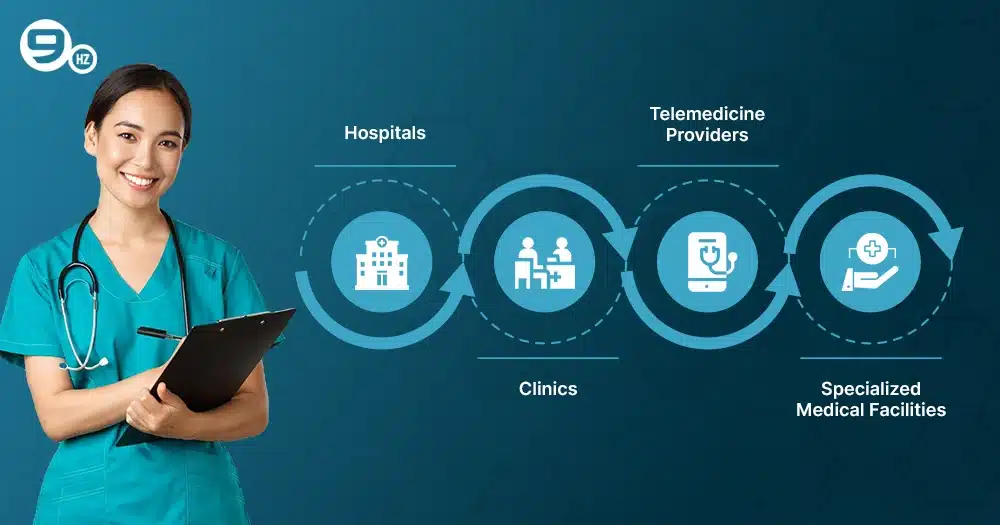
SaaS solutions bring different advantages for different healthcare segments and thus help them work efficiently. Let’s find out how different healthcare segments can leverage SaaS solutions.
Hospitals
Hospitals can use SaaS for various purposes such as patient scheduling, managing EHR, billing, and more. They can also leverage SaaS solutions to enhance operational efficiency, patient care, coordination, and more. These enable medical professionals to get real-time patient data from any location.
Clinics
For clinics, SaaS is helpful in streamlining appointment booking, practice management, inventory management and patient intake. Since SaaS is a cloud-based system, it allows small clinics to improve their operation even without investing in any expensive infrastructure.
Telemedicine Providers
SaaS allows telemedicine providers to offer remote patient monitoring, deliver virtual consultations, secure communication, and more. These platforms offer full data privacy and HIPAA compliance while ensuring convenient access to healthcare.
Specialized Medical Facilities
Many specialized medical facilities like radiology centers, labs, rehabilitation units, and others use this solution mainly for specialized workflow including imaging management, information systems, patient recovery tracking, and more. As we know, SaaS is capable of automating many repetitive tasks; it improves both productivity and also service quality.
What are the Upcoming Trends in Healthcare SaaS?
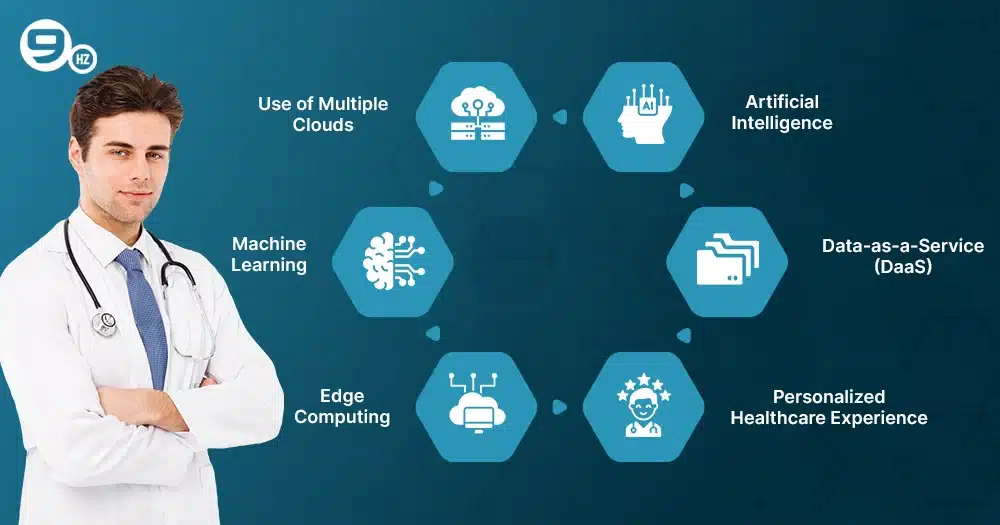
There are various upcoming trends in healthcare SaaS. These trends are all set to redefine the future of SaaS in healthcare. We will take a detailed overview of these trends that have vast potential to address current industry challenges. They also open up possibilities for personalized, efficient, and secure healthcare systems.
1. Use of Multiple Clouds
The adoption of multi-cloud strategies among many healthcare organizations has become a major trend. The main reason is it prevents organizations from minimizing their dependency on an individual provider and also improves their flexibility. It also helps them optimize their cost-efficiency.
With the multi-cloud approach, the healthcare organizations find it easy to manage their workloads easily. The system can distribute workload across various cloud platforms. It offers numerous advantages such as the ability to avoid vendor lock-in and increased data redundancy.
With different cloud providers, healthcare providers find it easy to choose the right platform that can match their specific requirements. This approach improves scalability and allows healthcare providers to cope with fluctuations in demand comfortably.
2. Machine Learning
Machine Learning (ML) in SaaS healthcare revolutionizes the ways to analyze and use medical data. ML algorithms have ample ability to analyze vast amounts of medical records, patient data, etc. Based on this, they can predict patient outcomes, find potential health risks, and advise treatment plans.
ML algorithms analyze patient’s historical data and predict readmission of patients, detect any early signs of disease, optimize treatment plans, and more.
ML algorithms can sift through massive amounts of patient data, medical records, and clinical trials to predict patient outcomes, suggest treatment plans, and identify potential health risks early.
With the advancement of Machine Learning, they are likely to offer more precise recommendations and improve patient care. It can also minimize healthcare costs.
3. Edge Computing
Edge computing has gained more importance of late in the healthcare industry. It’s useful for those apps that need real-time data processing. It’s different from traditional cloud computing which sends data to only a centralized server.
Instead, edge computing sends and processes data to local sources like IoT devices, medical sensors, or even local servers.
It minimizes latency and lets healthcare providers access important data in real-time. Edge computing is also helpful for making a quick decision. It’s important, especially in intensive care or any emergency situations.
4. Artificial Intelligence
After making a significant impact on numerous other industries, AI has also revolutionized the healthcare sector. It provides a range of advanced solutions for diagnostics, patient care, treatment planning, and more. AI-driven tools can automate various administrative tasks, analyze images, and much else.
Radiologists can utilize AI algorithms to identify different abnormalities in medical scans with greater accuracy than traditional methods. AI chatbots offer 24/7 support to patients, helping to reduce the workload for healthcare professionals.
5. Data-as-a-Service (DaaS)
Data-as-a-Service is another most popular upcoming trend in SaaS healthcare. It has the ability to address the increasing necessity for management, data storage, accessibility, and more.
With the help of DaaS, healthcare providers can store and manage even larger amounts of medical data in the cloud. It offers secure and also real-time access to those of many authorized users.
DaaS solutions allow many healthcare organizations to divide data silos, enhance collaboration, data sharing seamlessly, and more. It yields a better patient outcome with accurate diagnosis.
6. Personalized Healthcare Experience
Personalization witnessed its vast acceptance in many sectors – healthcare is certainly not an exception. SaaS platforms integrate personalized treatment plans according to patient-specific data, including lifestyle, genetic information, medical history, and more.
With the use of Machine Learning and AI, healthcare providers can provide personalized treatment recommendations, preventive care options, and wellness plans tailored to individual patients. This kind of personalized approach improves patient satisfaction. It enhances treatment adherence and also ensures better health outcomes.
How to Choose the Right Healthcare SaaS?
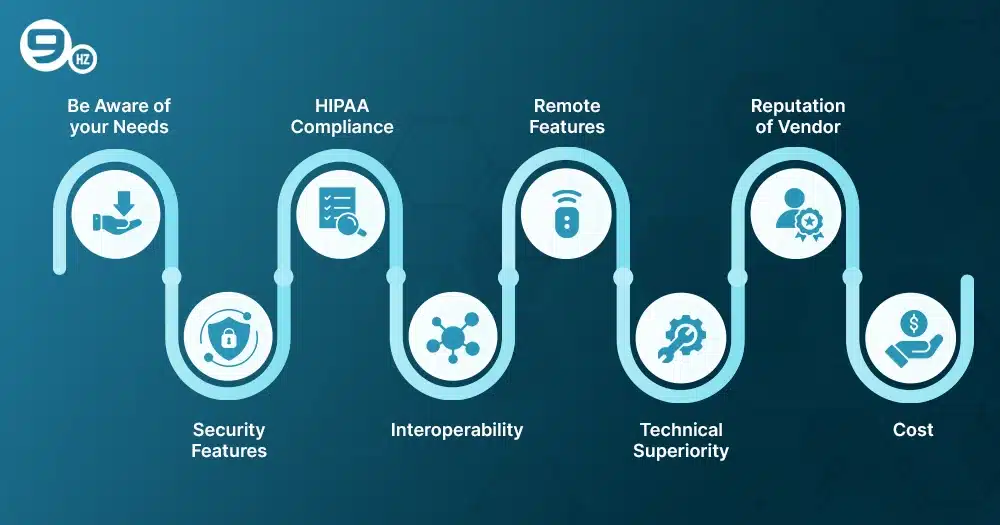
Selecting the right healthcare SaaS is a highly responsible task. You can keep in mind the following important factors to make the right decision and select the best option.
1. Be Aware of your Needs
Before you select the best healthcare SaaS, you can recognize the specific requirements of your organization. You can keep in mind several important functionalities such as appointment scheduling, patient management, telemedicine, billing, EHR, and more. It’s important to know your actual needs first and choose the best option accordingly.
2. Security Features
Security is indeed quite essential for the said solution to protect sensitive data. You can select the SaaS platform that includes security features such as secure access controls, data encryption, regular security audits, and more. A powerful security framework is helpful to protect against data breaches and also unauthorized access.
3. HIPAA Compliance
Make sure the solution you opt for comply with the HIPAA regulations. This compliance is necessary to offer protection of patient privacy. It’s also essential to avoid any legal risk for your healthcare organization.
4. Interoperability
Since many healthcare providers use various systems, they can choose a solution that includes the interoperability feature with the existing system. It facilitates smooth data exchange between different systems. It improves coordination of care and also operational efficiency.
5. Remote Features
The unprecedented growth of telehealth makes remote features quite necessary. Therefore, you should always look for products that include various remote features such as remote patient monitoring, virtual consultation, mobile access, and more. These features are a must-have to increase accessibility.
6. Technical Superiority
Before finalizing, you should not forget to know the technical capability of your selected SaaS solution. Make sure it has a user-friendly interface that minimizes the learning curve and thus improves productivity. You can also check enhancements and various regular updates to be familiar with the technological advancements.
7. Reputation of Vendor
Another important thing you can do is to check the reputation of your selected vendor. You can take enough time to research about them. Besides, going through testimonials, case studies, customer reviews, and more will also help you.
8. Cost
You should not forget to get details about the cost. It’s advisable to gather all details regarding initial costs, additional feature costs, subscription fees, potential savings, and more. These things help you analyze whether or not the solutions fit your budget.
You Might Be Interested In
10 Top SaaS Development Companies in India
20 Top SaaS Development Companies in USA
How can The NineHertz Help You Build Healthcare Saas Software?
We at The NineHertz, a reputed Healthcare Software Development Company, create tailored solutions to match the specific needs of your organizations. Our developers implement ongoing trends and cutting-edge technologies such as AI, ML, cloud computing, etc. to create advanced SaaS solutions.
We have expertise in creating SaaS healthcare software that is scalable, secure, and of course HIPAA-compliant. Whether you seek telemedicine platforms, EHR, or a patient management system, our team possesses vast proficiency in creating these. We are committed to transforming your operations, and thus improving your patient care.
Conclusion
So, after going through the above guide on SaaS for healthcare , you may understand its importance and benefits for medical professionals. If your organization has not adopted SaaS healthcare software, it’s the right time to do it. Partnering with organizations like The NineHertz helps you get top-notch solutions.
Frequently Asked Questions (FAQs)
1. What Is SaaS in Healthcare?
SaaS is basically a cloud-based app that helps healthcare organizations manage several tasks such as patient data, managing operations, and compliance. These platforms are effective in improving accessibility, minimizing IT costs, etc. Be it telemedicine, EHR, or billing, it makes the process of everything smooth.
2. How Does SaaS Differ from Traditional Healthcare Software?
Well, SaaS differs from traditional healthcare software in terms of cloud-enabled access. Due to this, the SaaS healthcare software is highly scalable and ensures real-time updates. SaaS is also different from traditional healthcare software in terms of installation. It can be installed on local servers.
3. Is SaaS Safe for Healthcare Organizations?
Yes, SaaS is safe for many healthcare organizations only when the right security measures are in place. It’s necessary to ensure its compliance with HIPAA for data protection. Meanwhile, secure access protocols and encryption are necessary to ensure the safety of those with sensitive information.
4. What Are the Top Healthcare SaaS Providers?
Some of the top healthcare SaaS providers are ZocDoc, eClinicalWorks, GE Healthcare, ABI Health, and more.
5. How Long Does It Take to Implement a SaaS Solution in A Healthcare Organization?
Well, implementation of a SaaS healthcare solution in any healthcare organization generally takes 3 to 6 months. This period is necessary for performing various tasks such as assessment, customization, integration, etc. You can get in touch with us to share your requirements. It helps us to know the total time we need to implement a SaaS solution.







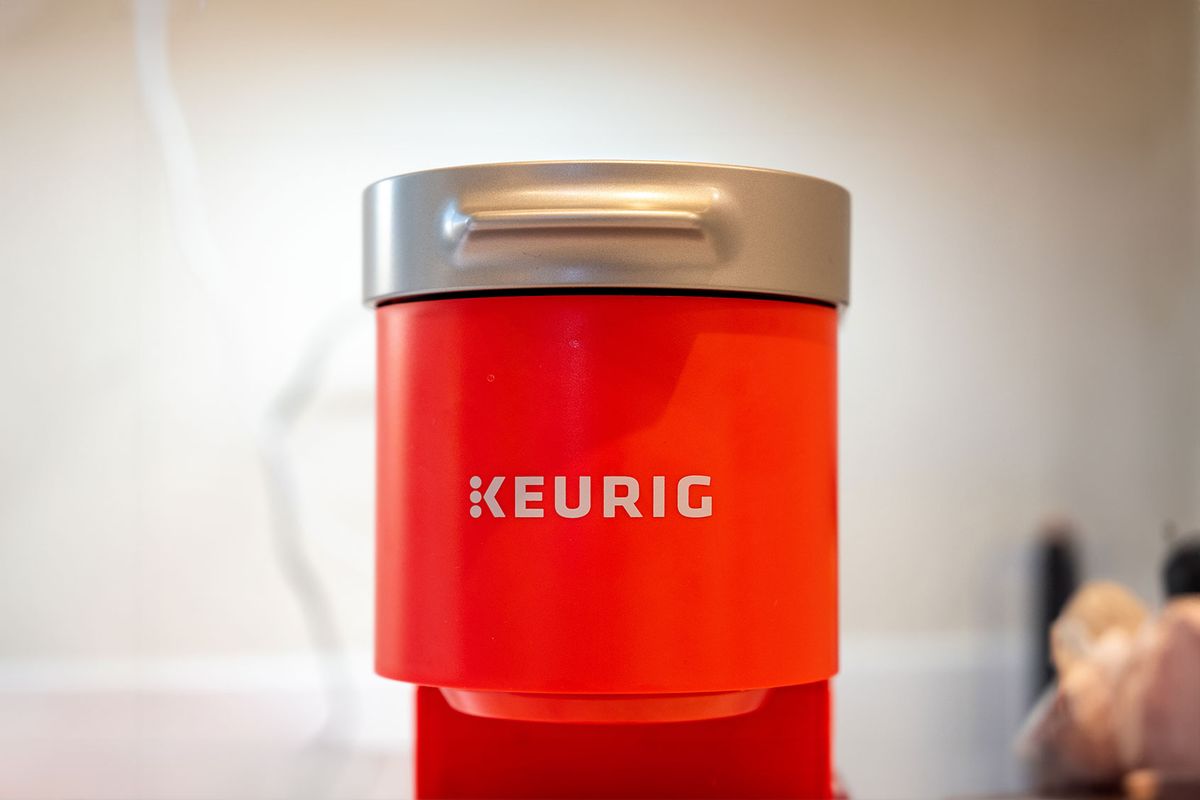












Discussion about this post